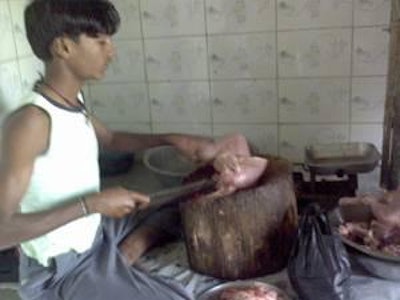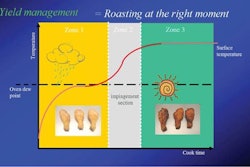
Indian consumers prefer to buy fresh meat from wet markets or live bird markets. A perception exists that fresh poultry meat purchased as a live bird and slaughtered in their presence is of better quality. Consumers lack confidence in chilled or frozen meat because they believe live birds have a better taste and texture.
Poultry meat has been the fastest growing sector of Indian animal production and consumption for the last three decades, growing at a compound annual rate of more than 11%. The annual per capita consumption of eggs and chicken meat has grown from 10 eggs and 146 grams in 1970's to about 44 eggs and 1.8 kilograms, presently.
Broiler market volatility
The Indian broiler sector operates almost completely as a live-bird market. Manual poultry processing accounts for more than 90% of consumption. Traditional poultry dressing facilities at the wholesale or retail level are completely manual, with no sanitary measures taken for the dressing floor or the workers. As a result, hygienic slaughtering and proper utilization of byproducts are currently the most important issues in the Indian meat industry.
Regional poultry production and consumption imbalances are also prevalent. The dominance of the live-bird market restricts the movement of poultry because of high mortality and shrinkage associated with transporting live birds. Broiler prices are based on demand and supply in a particular market on any particular day. A preference for live birds limits broiler meat consumption in markets where poultry consumers are sensitive to price.
A number of religious rituals in various regions of India adversely affect meat consumption leading to a significant drop in demand. Negligible sales of frozen products coupled with the limitation in inter regional movement of live birds, creates volatile broiler market prices. A shift to mechanical and more hygienic processing is integral to transition the broiler industry to a chilled/frozen-product market.
Transitioning to processed chicken
There is some demand for frozen or chilled poultry products from hotels, fast food restaurant chains and some urban consumers. About 6% of poultry meat is sold in processed form, of which only about 1% undergoes processing into value-added products (ready-to-eat/ready-to-cook).
The modern poultry processing sector in India consists of more than 12 firms, which are mostly operated by poultry integrators located in or near major urban areas. These firms use imported equipment and follow hygienic procedures, including monitoring employee health, water supplies, sanitary conditions and refrigeration facilities.
Chilled whole birds and parts are sold in markets and shops in major cities. Acceptance of chilled meat is higher than that of frozen meat, yet growth in chilled meat consumption could help to accelerate the transition to frozen poultry products.
Consumer acceptance
Growth in the retail segment is being encouraged by new approaches from poultry integrators, including establishing integrator-owned or franchised chilled/frozen poultry shops, opening sales counters in existing food shops, and home delivery services. The recent emergence of supermarkets and shopping malls is also supporting growth in the retailing of chilled/frozen poultry products.
Most poultry integrators in India are marketing dressed and chilled products, and ready-to-cook and ready-to-eat poultry products to institutional and retail customers. With the establishment of modern Hazard Analysis Critical Control Point certified processing plants, many processed chicken brands are becoming popular in urban India. Consumers are paying more attention to quality and hygienic food and the demand for processed meat and meat products is increasing.
Creating standards
To streamline the meat and poultry processing industry and the production of clean and hygienic meat products, the government of India launched the National Meat and Poultry Processing Board. The board is raising domestic standards in meat and poultry processing to international levels; developing uniform and effective meat quality testing systems and improving conditions in the wet-market. The National Meat and Poultry Processing Board addresses:
- Laying down policies for healthy development of the meat and poultry sector;
- Raising domestic standards to international levels;
- Addressing current environmental pollution issues created by slaughterhouse waste materials;
- Developing uniform and effective national meat quality testing systems and laboratories;
- Setting up training institutes for workers, technicians and managers in meat processing industries;
- Providing research and development for production and marketing of new value-added meat products for domestic and international markets;
- Serving as a 'one-stop' service for producers, manufacturers and exporters of meat and meat products;Adopting meat production and processing;
- Promoting and regulating the meat industry for increasing exports;
- and, helping the industry establish sustainable and viable commercial projects.
Future growth potential
The board plans to modernize abattoirs within five years by standardizing size, technologies, equipments and benchmarking and establishing a consultancy division. The board also will establish five quality control and analytical laboratories for meat and meat products by July 2012 to meet domestic and international market standards.
Tremendous growth potential for the Indian broiler industry exists provided consumers are educated on the benefits of processed hygienic poultry products. The National Meat and Poultry Processing Board has a greater role to play to educate consumers about the possible health hazards of chicken bought from a wet market as well as to accelerate the pace of the transition.
Transition from a live-bird market to a chilled/frozen poultry product market is an important factor in the future expansion of broiler production. Expansion of the poultry industry could create potential trade and investment opportunities.
.jpg?auto=format%2Ccompress&crop=faces&fit=crop&h=48&q=70&w=48)


















